Naimisharanya
BY: SUN STAFF
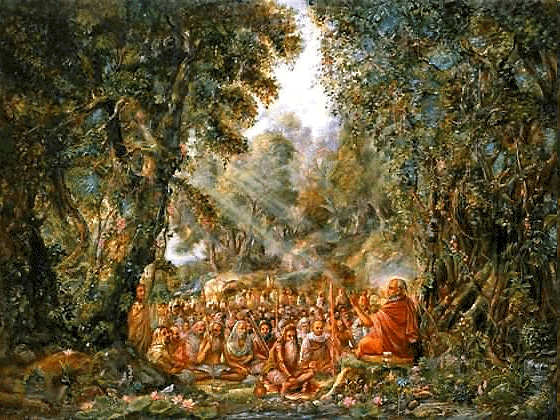
The Sages at Naimisharanya ![]() Bhaktivedanta Book Trust
Bhaktivedanta Book Trust
Jan 05, CANADA (SUN) — A serial exploration of the sacred Tirtha at Naimisharanya.
The forest of Naimisharanya is the aranya svarupa or forest manifestation of Lord Vishnu, and is therefore considered a sacred tirtha. Over the ages, it is said that more than 60,000 sages have lived in Naimisharanya forest (aranya means 'forest'). Today the place is commonly known as Nimsar, a village on the bank of the River Gomti in Uttar Pradesh. Located about 100 km. from Lucknow, Naimisharanya continues to be an important place of pilgrimage for devotees, who go there to glorify the crown jewel of Vaisnava literature, the Srimad-Bhagavatam. The Bhagavatam was recited by Suta Goswami at the beginning of this Kali yuga, after the battle of Kurukshetra. 33,000 sages headed by Saunaka Rishi received the Bhagavatam directly from Sri Suta Goswami here.
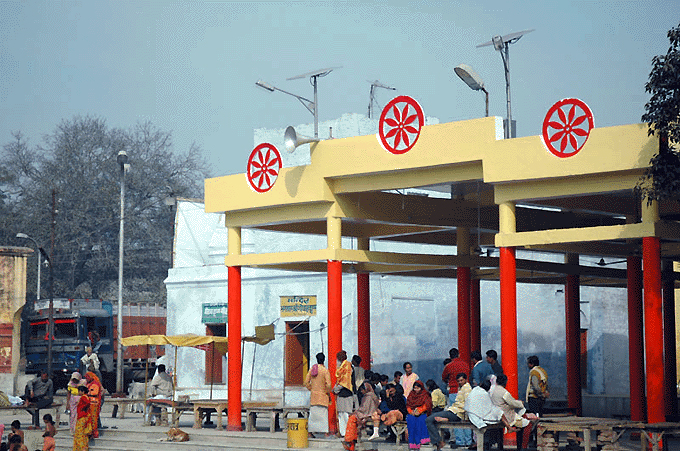
Chakra Teerath
As described in the Introduction to Srila Prabhupada's Srimad-Bhagavatam:
"After compiling the Bhagavatam, Vyasa imparted the synopsis of it to his son, the sage Sukadeva Gosvami. Sukadeva Gosvami subsequently recited the entire Bhagavatam to Maharaja Pariksit in an assembly of learned saints on the bank of the Ganges at Hastinapura (now Delhi). Maharaja Pariksit was the emperor of the world and was a great rajarsi (saintly king). Having received a warning that he would die within a week, he renounced his entire kingdom and retired to the bank of the Ganges to fast until death and receive spiritual enlightenment. The Bhagavatam begins with Emperor Pariksit's sober inquiry to Sukadeva Gosvami: "You are the spiritual master of great saints and devotees. I am therefore begging you to show the way of perfection for all persons, and especially for one who is about to die. Please let me know what a man should hear, chant, remember and worship, and also what he should not do. Please explain all this to me."
Sukadeva Gosvami's answer to this question, and numerous other questions posed by Maharaja Pariksit, concerning everything from the nature of the self to the origin of the universe, held the assembled sages in rapt attention continuously for the seven days leading up to the king's death. The sage Suta Gosvami, who was present in that assembly when Sukadeva Gosvami first recited Srimad-Bhagavatam, later repeated the Bhagavatam before a gathering of sages in the forest of Naimisaranya. Those sages, concerned about the spiritual welfare of the people in general, had gathered to perform a long, continuous chain of sacrifices to counteract the degrading influence of the incipient age of Kali. In response to the sages' request that he speak the essence of Vedic wisdom, Suta Gosvami repeated from memory the entire eighteen thousand verses of Srimad-Bhagavatam, as spoken by Sukadeva Gosvami to Maharaja Pariksit.
The reader to Srimad-Bhagavatam hears Suta Gosvami relate the questions of Maharaja Pariksit and the answers of Sukadeva Gosvami. Also, Suta Gosvami sometimes responds directly to the questions put by Saunaka Rsi, the spokesman for the sages gathered at Naimisaranya. One therefore simultaneously hears two dialogues: one between Maharaja Pariksit and Sukadeva Gosvami on the bank of the Ganges, and another at Naimisaranya between Suta Gosvami and the sages at Naimisaranya forest, headed by Saunaka Rsi. Furthermore, while instructing King Pariksit, Sukadeva Gosvami often related historical episodes and gives accounts of lengthy philosophical discussions between such great souls as Narada Muni and Vaasudeva. With the understanding of the history of the Bhagavatam, the reader will easily be able to follow its intermingling of dialogues and events from various sources. Since philosophical wisdom, not chronological order, is most important in the text, one need only be attentive to the subject matter of Srimad-Bhagavatam to appreciate fully its profound message."
At Naimisharanya, Srila Vedavyasa instructed his disciples in the Vedas and Puranas. His disciple Lomaharshana narrated the Puranas to the sages here, in much the same way that Suta Goswami later recited the Bhagavatam to the sadhus at Naimisharanya during the 1,000 year yagna of Shaunaka.
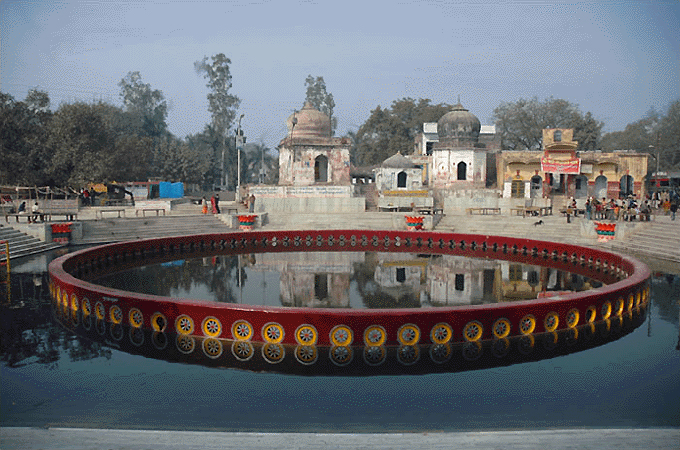
Chakra Kunda at Naimisharanya
Naimisharanya is mentioned in several of the Puranas. The Vayu Purana describes how in the Satya Yuga, the sages wanted to perform a large yagna, and requested Lord Brahma to guide them in identifying an appropriate location. Brahmadeva created a huge wheel, the Manomaya Chakra, which he dedicated to Lord Shiva. Releasing the chakra, he told the sages to follow it, instructing them to hold their sacrifice at the place where the wheel broke. It landed in the forest at Naimisharanya and as predicted, it broke. In Sanskrit, 'naimi' refers to the circumference of the wheel.
Where the wheel cracked, a huge fountain of water emerged from the earth in the shape of a linga, and threatened to flood the forest. The sages were panicked, but the goddess Shakti appeared and stopped the gushing water. The place where this Manomaya Chakra landed, rupturing the ground, is a very sacred spot.
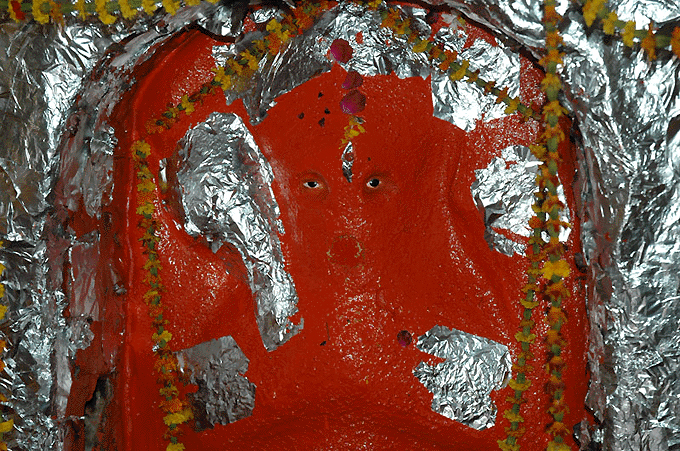
Shakti Devi
In the Varaha Purana, it states that Lord Vishnu once destroyed an entire army of asuras in one second at Naimisharanya, with His Chakra. 'Nimish' means 'an instant', and refers to the place in Naimisharanya forest where this pastime took place.
Chakra Teerath is not only considered to be the holiest site in Naimisharanya, it is also said to be the epicenter of Prithvimandala (the earth planet). Many prominent rishis came tot his place to perform continual yajnas during the Satya yuga, including Maharishi Shringi, Maharishi Dalabhaya, Maharishi Udallak, Maharishi Shikamketu, Maharishi Pravaan, and many others. Today, devotees taking bath in the Chakra Kunda to be purified from sinful activities. Many come here to offer pinda to the ancestors, as well.
Pilgrims also come to Naimisharanya to get darshan of Veda Vyasa at his Vyasa Peeth, and they visit the Dadheechi Kunda, associated with the sage Dadheechi. The Shakti Peeth is said to mark the place of the emergence of Shakti Devi at Naimisharanya, and the Linga Dharini Shakti temple is associated with this pastime.
In the segments to follow, we will visit the many temples, shrines, and holy sites at Naimisharanya Tirtha.
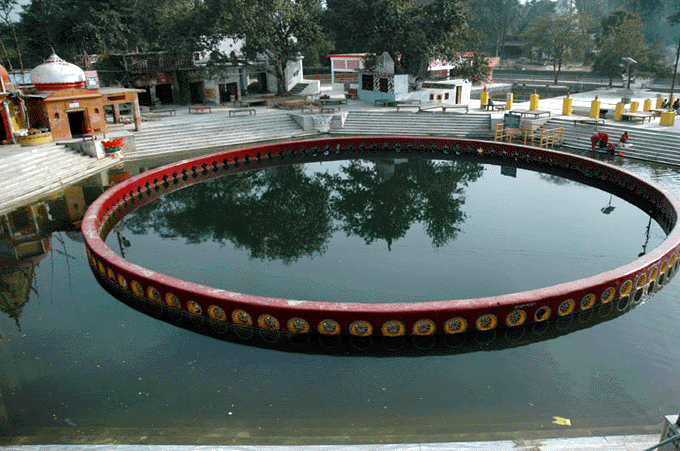
Chakra Kunda
Photos courtesy of Naimish Trust.
Naimisharanya, Part Five
BY: SUN STAFF
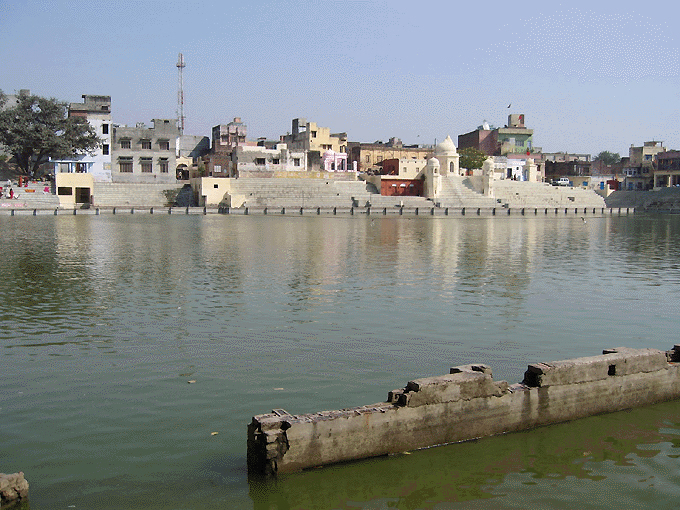
Dadhichi Kund, Naimisharanya
Jan 09, CANADA (SUN) — A serial exploration of the sacred Tirtha at Naimisharanya.
Among the many inconceivable pastimes that have taken place at the Holy Dhama of Naimisharanya are those of the great sage Dadhichi. Maharishi Dadhichi was not only a highly advanced rishi, but also a great Vedic king. He was the son of Atharvan and the father of Maharishi Pippalada.
Dadhichi's mother, Atharva Rishi's wife, was Chitti, the daughter of the sage Kardam. His wife's name was Swarcha. Dadhichi's name is found in the 1st mandala of Rigveda, in the Bhagavata Purana, Srimad Devi Bhagavatam, and in the Puranas. Dadhichi Rishi is said to be the forefather of many other great rishis and clans, such as the Dadhich, who claim to be his direct descendants.
Dadhichi donated his bones to the Devathas, so they could make a weapon to defeat the Vritra asura. This demon was a brahmin who became the head of the Asuras. Not a demon such as the demigods who take the part of demons in order to participate in the Lord's lilas, this Vritasura was inherently demoniac, and violently battled the Devas.
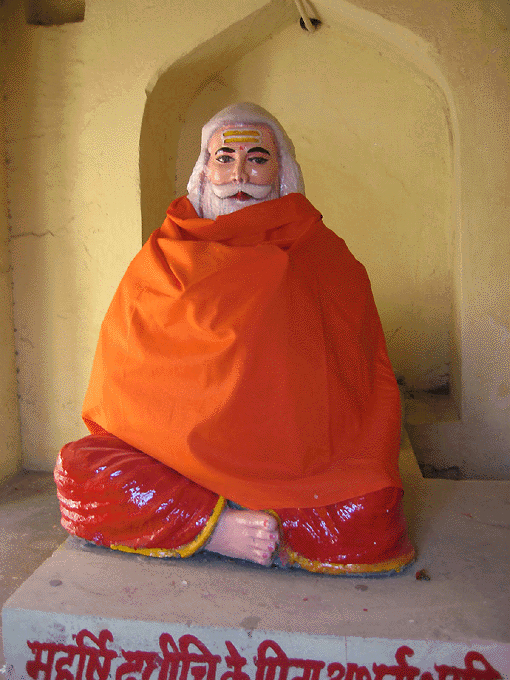
Murti of Dadhichi Maharishi
They Devas eventually took shelter of Lord Indra, and they approached Lord Vishnu for assistance. He advised them that Vritrasura could not be destroyed by ordinary means, and that a special weapon would be required to slay him – a weapon made from the bones of a great sage.
Although the Devathas doubted that such a sage would freely donate his bones, Visnu directed them to Rishi Dadhichi. When approached, the great sage gladly gave up his bones for the benefit of mankind, and these Indra used to make the Vajra thunder weapon.
A few kilometers away from Naimisharanya is the Dadhichi Kund in Mishrik, where the great sage bathed in the waters of the holy tank before giving his bones, and his mortal life.

The place where Dhadhichi sacrificed his backbone
Photos courtesy of Dr. S. Perisepalli.
Replies